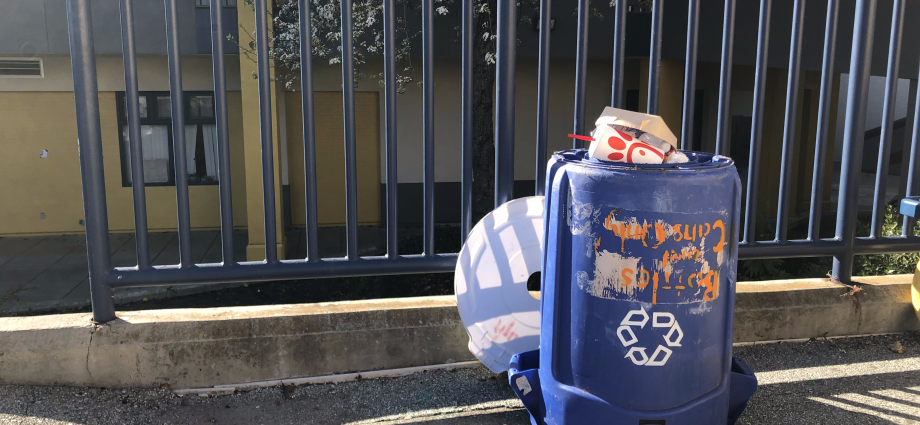Recycling operations have changed in MUSD over time, and they currently include a longstanding paper recycling program and a more recently developed bottle-and-can recycling program, according to Thomas Russell Middle School (TRMS) recycling coordinator and teacher Barbara Knitter. Knitter had formerly coordinated recycling across the district, she added.
“I was doing it district-wide until all the other schools had recycling bins and programs in place,” Knitter said. “Then COVID happened, things kind of fell to the wayside, and I wasn’t getting paid for it or anything. So, I just kind of let it go, and no one’s asked me to continue it.”
A paper-recycling dumpster was added to the MHS campus in 2014, according to Environmental Society advisor and science teacher Glen Barrett.
“We finally got the white big dumpster out in the parking lot, which does get used significantly; I think it gets filled every couple of days,” Barrett said. “That dumpster was huge in changing our recycling on campus.”
Later, in 2016, MHS supplied each classroom with new blue paper-recycling bins, and teachers could either manually empty their bins into the paper-recycling dumpster or into a collective bin for their department, Barrett said. In recent years, paper waste production has decreased, he added.
“My paper production went way down when Google Classroom kicked in,” Barrett said. “Mine (recycling bin) fills up so rarely that, every so often, I’ll take it over to the white bin, but usually I don’t because there’s so little of it.”
Custodian Zenaido Alvarez said that the custodians will generally empty the classroom recycling bins and collective bins into the recycling if they notice that the bins are full. However, there are no strict guidelines, and this process can vary from custodian to custodian, he added.
The waste disposal company Republic Services processes paper recycling within the district, and allows any type of unsoiled paper to be recycled, Superintendent Cheryl Jordan said. The provider differs from the city of Milpitas’ provider, she added.
“Republic gave the school district a much better contract option,” Jordan said. “Also, Republic has a long record of providing our teachers with mini-grants. So we, as a district, felt that Republic better met our needs as a learning organization.”
Around the 2015-16 school year, the state of California required all government agencies, including schools, to have a recycling system in place, Knitter said. When Milpitas city officials reviewed MUSD schools, none had bottle-and-can recycling programs as developed as TRMS, she said.
“They started going to the middle schools, came to Russell, and were astonished by what they saw,” Knitter said. “They came to me and said, ‘We want you to do what you’re doing at Russell districtwide.’”
With the help of her AVID students, Knitter distributed recycling bins to other schools in the district and designated recycling coordinators, who were volunteer teachers that oversaw the maintenance of these bins, Knitter said. While overseen by teachers, the operations themselves were generally student-run to avoid additional strain on custodians, she added. Still, collections remained limited to items that could be cashed in at recycling centers, Knitter said.
“We were only interested in bottles and cans so the money could come back to the school,” Knitter said. “For anything else, we would love to have a program, but it was just too intense labor.”
At MHS, bottle-and-can recycling bins are picked up by Environmental Society student volunteers and cleaned out every few weeks, and all bottles and cans are traded in at a recycling center so that funds can come back to the club, Barrett said. However, there is often an issue of students placing their bottles into the wrong bins, he added.
At TRMS, Knitter combatted this challenge by educating the campus with student-made educational videos, she said.
“The first three years that I did the recycling program, the garbage cans and the recycling bins looked identical,” Knitter said. ”It wasn’t until I started doing the videos schoolwide, until those education elements began, that they started to look correct.”
Jordan said that no major changes are currently planned for the recycling program.
“The structure is there,” Jordan said. “We just need to be consistent following it.”

